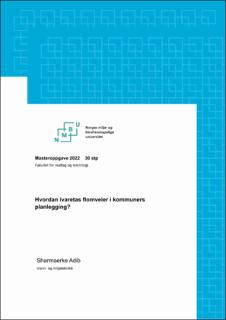| dc.contributor.author | Adib, Sharmaerke Hussein | |
| dc.contributor.editor | Rydningen, Ulf | |
| dc.coverage.spatial | Norway | en_US |
| dc.date.accessioned | 2022-10-28T08:09:57Z | |
| dc.date.available | 2022-10-28T08:09:57Z | |
| dc.date.issued | 2022 | |
| dc.identifier.uri | https://hdl.handle.net/11250/3028765 | |
| dc.description.abstract | Tradisjonelt har håndteringen av overvann vært å lede det bort fra overflaten og ned i et ledningssystem under bakken, som er skjult fra omgivelsen. Før eller senere vil konsekvensen av en slik håndtering være at vannmengden blir større enn det overvannssystemet er dimensjonert for, og da vil det forurensede avløpsvannet stuves opp til terrenget og opp til overflaten. Tretrinnsstrategien er sentralt i utformingen av alle kommuners overvannsplan og brukes som en standard for overvannshåndtering. Overvann skal med andre ord være en ressurs for kommuner og ikke en belastning på infrastrukturen.
Klimaendringer innebærer endringer i nedbørsmønstre og hvor ofte ulike type vær forekommer. For å unngå at byene oversvømmes av overvann, må kommunene ha en plan for overvannsplanlegging. For å få en helhetlig forståelse og lære mer om hvordan gater og veier blir ivaretatt i kommunenes plan for overvannsplanlegging for flomsituasjoner, ble det benyttet et kvalitativt intervju med litteraturstudie. Det ble blant annet observert at Bærum og Stavanger kommune benytter seg av tretrinnsstrategien som den grunnleggende overvannshåndteringen i kommunen, men når det kommer til den kommunale arealdelen, så er ikke tretrinnsstrategien forankret juridisk. Dette er ikke annerledes enn de analyserte kommunene i masterhandlingen.
For å forberede oss i fremtiden, er det viktig at det kommer tydelige nasjonale føringer og at det føres politiske kampanjer i politikken, som kan bidra til et tverrfaglig samarbeid mellom alle aktører i samfunnet. Det overordnede målet med oppgaven er å rette oppmerksomheten på et tema som kan påvirke våre liv i stor skala i fremtiden. Mange kommuner har utført omfattende arbeid med overvannshåndtering, men vi har fortsatt et stykke vei å gå. Man kan blant annet opplyse befolkningen med informasjon om overvann, og det kan komme i form av nettportaler, informasjoner og veiledning. | en_US |
| dc.description.abstract | Traditionally, surface water has been lead from the surface into a pipe system under the ground. The consequences of such flows can be that the amount of water is greater than the capacity which the such surface water management system is dimensioned for which inturn leds to an overflow that gets stored up to the terrain or as floods on the surface. Mucipalities use the three-step strategy as a central tool in the design of surface water plan and is used as a standard for surface water management.
Climate change involves changes in precipitation patterns and how often different types of weather occur. To prevent cities from being flooded by surface water, municipalities must have a plan for surface water planning. A qualitative interview with a literature study was used in this masterthin order to gain an understanding and learn more about how streets and roads are taken care of in the municipalities' plan for surface water planning for flood situations. Among other things, it was observed that Bærum and Stavanger municipality use the three-step strategy as the basic surface water management in the municipality. However, it was noted that the three-step strategy is not legally binding in these municipalities. This is no different from the analyzed municipalities in master's thesis.
In order to prepare for the future, it is important that there are national guidelines and political campaigns that contribute to an interdisciplinary collaboration between all actors in society. The overall goal of the thesis is to draw attention to a topic that will affect our lives on a large scale in the future. Many municipalities have carried out extensive work with surface water management but nethertheless there is still have a long way to go. Informing the population with information about surface water, and it can come in the form of web portals, information and guidance is a example of how surface water can be managed at individual level using the first two steps in the three-step strategy. | en_US |
| dc.language.iso | nob | en_US |
| dc.publisher | Norwegian University of Life Sciences, Ås | en_US |
| dc.rights | Attribution-NonCommercial-NoDerivatives 4.0 Internasjonal | * |
| dc.rights.uri | http://creativecommons.org/licenses/by-nc-nd/4.0/deed.no | * |
| dc.title | Hvordan ivaretas flomveier i kommuners planlegging? | en_US |
| dc.type | Master thesis | en_US |
| dc.description.localcode | M-VM | en_US |

